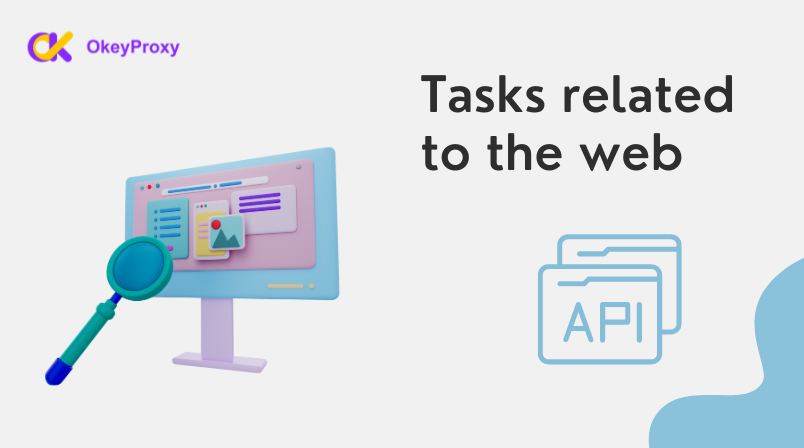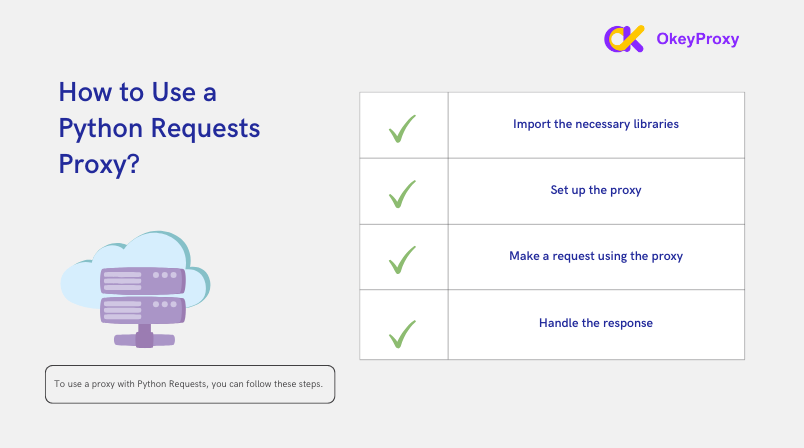Proxys sind entscheidend für die Gewährleistung der Anonymität, die Umgehung von Ratenbeschränkungen und die Umgehung von Geobeschränkungen bei der Arbeit mit Python-basierten Anwendungen, insbesondere für das Web-Scraping und die Automatisierung mit mehr als einer Million realer und konformer Einwohner. Dieser Artikel soll das Konzept der Python-ProxyIn diesem Buch werden die Grundlagen der Verwendung von Proxys in Python erläutert, wobei detailliert beschrieben wird, wie man sie konfiguriert, Proxy-Bibliotheken nutzt und Proxys für verschiedene Online-Aufgaben effektiv verwaltet.
Was ist ein Python-Proxy?
Ein Proxy fungiert als Vermittler zwischen Ihrem Python-Skript und dem Zielserver und leitet Ihre Anfragen über eine andere IP-Adresse weiter. Dies hilft, Ihre Identität zu verschleiern, den Datenschutz zu verbessern, IP-Sperren zu vermeiden und den Datenverkehr über mehrere Endpunkte zu verteilen, was besonders beim Web Scraping, Data Harvesting und beim Schutz der Privatsphäre nützlich ist.
Proxy-Muster, implementiert in Python:
Beim Softwaredesign beinhaltet ein Proxy-Muster die Erstellung einer neuen Klasse (des Proxys), die die Schnittstelle einer anderen Klasse oder Ressource nachahmt, aber eine Form von Kontroll- oder Verwaltungsfunktionalität hinzufügt. Dies kann zum Beispiel für träges Laden, Protokollierung, Zugriffskontrolle oder andere Zwecke verwendet werden. Die dynamische Typisierung und die umfangreiche Unterstützung von Klassen machen Python zu einer guten Sprache für die Implementierung von Proxy-Mustern.
Warum Proxy in Python verwenden?

Die Verwendung eines Proxys in Python kann sowohl die Sicherheit als auch die Funktionalität bei Netzwerkanfragen erheblich verbessern. Proxys fungieren als Vermittler zwischen einem Client und einem Server und ermöglichen es dem Client, seine Anfragen über die IP-Adresse des Proxys statt über seine eigene zu leiten. Auf diese Weise lässt sich die Identität des Clients verschleiern, was für den Schutz der Privatsphäre und die Vermeidung von IP-Sperren beim Scraping von Websites oder beim Zugriff auf eingeschränkte Inhalte von entscheidender Bedeutung ist. Außerdem können Proxys geografische Beschränkungen umgehen und die Leistung von Anfragen durch Lastausgleich verbessern. In Python lassen sich Proxys leicht in Bibliotheken wie Requests integrieren, was sie zu einem vielseitigen Werkzeug für Entwickler macht, die Netzwerkinteraktionen verwalten.
Hier sind einige Gründe für die Verwendung von Python-Proxys:
- Umgehung von Beschränkungen: Mit Python Proxy können Sie Zugriffsbeschränkungen durch Firewalls, Filter oder standortabhängige Sperren umgehen. Durch die Verwendung von Proxys von verschiedenen Standorten oder Netzwerken aus können Sie auf Inhalte zugreifen, die in Ihrem Gebiet oder Netzwerk möglicherweise nicht verfügbar sind.
- Lastverteilung und Skalierbarkeit: Python Proxy ermöglicht es Ihnen, Ihre Anfragen auf mehrere Server zu verteilen. So können Sie mehr Anfragen auf einmal bearbeiten und Ihr Programm skalierbar machen.
- Anonymität und Datenschutz: Proxys ermöglichen es Ihnen, Ihre IP-Adresse zu verbergen, was zusätzliche Privatsphäre und Sicherheit bietet. Indem Sie Ihre Anfragen über verschiedene Proxyserver senden, können Sie verhindern, dass Websites Ihre tatsächliche IP-Adresse ermitteln und verfolgen.
- Abschwächung der IP-Blockierung: Wenn Sie eine Website scrapen oder viele Anfragen stellen, könnten Sie gesperrt werden, wenn Ihr Verhalten verdächtig erscheint oder eine bestimmte Grenze überschreitet. Python-Proxy-Server helfen, dieses Risiko zu mindern, indem sie Ihnen erlauben, zwischen verschiedenen IP-Adressen zu wechseln. Dadurch werden Ihre Anfragen gestreut und die Wahrscheinlichkeit, aufgrund Ihrer IP-Adresse blockiert zu werden, verringert.
- Geografisches Targeting: Mit Python-Proxys können Sie Ihre Anfragen so aussehen lassen, als kämen sie von verschiedenen Orten. Dies kann hilfreich sein, wenn Sie Funktionen testen, die von Ihrem Standort abhängen, oder wenn Sie regionale Informationen von Websites abrufen möchten.
- Lastverteilung und Skalierbarkeit: Python Proxy ermöglicht es Ihnen, Ihre Anfragen auf mehrere Server zu verteilen. So können Sie mehr Anfragen auf einmal bearbeiten und Ihr Programm skalierbar machen.
- Optimierung der Leistung: Proxys mit Cache-Funktion können die Leistung verbessern, indem sie gespeicherte Antworten bereitstellen, anstatt wiederholte Anfragen an den Zielserver zu senden. Dadurch wird die Menge der verwendeten Daten reduziert und die Antwortzeiten werden verkürzt, insbesondere bei häufig genutzten Diensten.
- Testen und Entwickeln: Mit Python Proxy können Sie Netzwerkdaten erfassen und anzeigen, was sie zu nützlichen Werkzeugen für Tests und Fehlersuche macht. Wie Ihr Python-Skript mit dem Zielserver kommuniziert, können Sie anhand der Anfragen und Antworten sehen.
- Vielseitigkeit und Flexibilität: Python Requests und Proxies können für eine Vielzahl von Aufgaben im Zusammenhang mit dem Web eingesetzt werden. Ganz gleich, ob Sie Daten abrufen, Prozesse verwalten oder APIs verwenden, diese Kombination ermöglicht es Ihnen, Ihre Anfragen zu ändern und an Ihre Bedürfnisse anzupassen.

Python Proxies: Innovativer Ansatz für Web Scraping
Wie man einen Proxy-Server in Python erstellt
Das Einrichten eines Proxys in Python ist einfach. Nachfolgend finden Sie die grundlegenden Schritte zur Integration eines Proxys in Ihr Web-Scraping- oder Automatisierungsskript:

- Erforderliche Bibliotheken installieren: Verwenden Sie gängige Bibliotheken wie
Anfragenoderhttpxum Proxys zu konfigurieren. - Wählen Sie einen Proxy-Typ: Entscheiden Sie, ob Sie je nach Ihren Anforderungen HTTP-, HTTPS-, SOCKS5- oder Residential-Proxys verwenden möchten.
- Konfigurieren Sie den Proxy: Legen Sie die Proxy-URL in der Anfrage fest, um den Datenverkehr über den Proxyserver zu leiten.
- Behandlung von Fehlern: Implementieren Sie eine Fehlerbehandlung, um Proxy-Verbindungsfehler, Timeouts oder blockierte Anfragen abzufangen.
Proxy in Python-Anfragen einstellen
Um einen Proxy mit Hilfe von Python-Anfragen einzurichten, müssen Sie bestätigen, dass Sie über die erforderlichen Berechtigungen und Rechte verfügen, um den konfigurierten Python-Proxy zu verwenden.
Die requests-Bibliothek ist ein beliebtes Python-Paket zum Senden verschiedener HTTP-Anfragen. Sie können sie mit pip, dem Python-Paketinstallationsprogramm, installieren. Pip wird normalerweise automatisch installiert, wenn Sie Python installieren, aber Sie können es auch separat installieren, wenn Sie es brauchen.
-
Eingabeaufforderung öffnen
A. Windows: Suchen Sie im Startmenü nach "CMD" oder "Eingabeaufforderung".
B. MacOS: Öffnen Sie Terminal unter Programme > Dienstprogramme.
C. Linux: Öffnen Sie Terminal aus dem Menü Anwendungen.
-
Prüfen, ob Python installiert ist
Bevor Sie die Bibliothek installieren, sollten Sie prüfen, ob Python bereits installiert ist.
-
Prüfen Sie, ob pip installiert ist
Prüfen Sie, ob pip installiert ist. Bei den meisten modernen Python-Installationen ist PIP bereits vorinstalliert.
Nachdem Sie die requests-Bibliothek erfolgreich installiert haben, können Sie jetzt HTTP-Anfragen in Python stellen.
Beispiel für die Verwendung eines Proxy für Python-Anfragen
Einfuhranträge
# Beispiel für die Einstellung eines Proxys
proxies = {
'http': 'http://user:password@proxy.example.com:8080',
'https': 'https://user:password@proxy.example.com:8080',
}
response = requests.get('https://example.com', proxies=proxies)
print(response.content)
Hinweis: Während die requests-Bibliothek eine einfache Möglichkeit bietet, Python-Proxy zu verwenden, können komplexere Anwendungen erweiterte Bibliotheken wie Scrapy. Scrapy ist ein Python-Framework für großangelegtes Web-Scraping, das alle Werkzeuge bereitstellt, die für die Extraktion von Daten aus Websites, ihre Verarbeitung und Speicherung im bevorzugten Format erforderlich sind, und unterstützt Drehbevollmächtigtewie z.B. OkeyProxy.
Erweiterte Python-Proxy-Bibliotheken
Über die grundlegenden Anfragen Bibliothek bieten mehrere Python-Bibliotheken erweiterte Funktionen für die Proxy-Verwaltung. Hier ist ein Blick auf einige innovative Lösungen:
- httpx: Ein moderner, asynchroner HTTP-Client, der Folgendes unterstützt Proxy-Rotation und gleichzeitige Anfragen für schnelleres Scraping.
- Selen: Selenium wird häufig für die Web-Automatisierung verwendet und kann mit Proxies konfiguriert werden, um Headless-Browser-Sitzungen effektiv zu verwalten.
- PySocks: Ein leichtgewichtiger SOCKS-Proxy-Wrapper für das Socket-Modul von Python, perfekt für den Umgang mit SOCKS5-Proxies.
Beispiel für die Verwendung von Python httpx proxy
httpx importieren
# Verwendung von httpx mit einem Proxy
proxies = {
'http://': 'http://proxy.example.com:8080',
'https://': 'https://proxy.example.com:8080'
}
async mit httpx.AsyncClient(proxies=proxies) as client:
response = await client.get('https://example.com')
print(response.text)
Erfahren Sie als Praktiker mehr über Scraping von Benutzerkonten auf Instagram und TikTok oder Erstellung eines Walmart-Preisverfolgers mit Python-Proxy.
Verwaltung des Python-Proxys für Scale
Rotierende Proxies in Python
In Situationen, in denen umfangreiches Web Scraping erforderlich ist, Drehbevollmächtigte notwendig werden, um zu verhindern, dass die IP des Proxy-Servers blockiert wird. Python vereinfacht diesen Prozess.
Die Entwickler können eine Liste von Python-Proxys erstellen und für jede Anfrage einen anderen auswählen:
Anfragen importieren
importieren zufällig
proxy_list = ["http://proxy1.com:3128", "http://proxy2.com:8080", "http://proxy3.com:1080"]
url = "http://example.org"
for i in range(3):
proxy = {"http": random.choice(proxy_list)}
response = requests.get(url, proxies=proxy)
print(antwort.status_code)Außerdem können Skripte mit einem Pool von Python-Proxys die IP-Adressen nach jeder Anfrage oder in bestimmten Abständen wechseln:
von itertools importieren Zyklus
# Liste der Proxys
proxy_pool = cycle([
'http://proxy1.example.com:8080',
'http://proxy2.example.com:8080',
'http://proxy3.example.com:8080'
])
# Rotieren durch die Proxys
for i in range(10):
proxy = next(proxy_pool)
response = requests.get('https://example.com', proxies={"http": proxy, "https": proxy})
print(antwort.status_code)
Proxy-Authentifizierung mit Python
Einige Proxys erfordern eine Authentifizierung. Python kann mit Proxys umgehen, die Benutzernamen und Kennwörter benötigen, und so sicherstellen, dass Anfragen sicher durch private Proxynetzwerke geleitet werden.
proxies = {
'http': 'http://user:password@proxy.example.com:8080',
'https': 'https://user:password@proxy.example.com:8080'
}
response = requests.get('https://example.com', proxies=proxies)
Python Proxy Failover und Erro
Nicht alle Proxys sind zuverlässig. Durch die Implementierung von Fehlerbehandlungs- und Failover-Mechanismen wird sichergestellt, dass Ihr Python-Skript auch dann weiterläuft, wenn ein Proxy ausfällt. Verwenden Sie Wiederholungsmechanismen, um Unterbrechungen zu vermeiden.
import requests
from requests.exceptions import ProxyError
# Grundlegende Proxy-Failover-Logik
proxies = ['http://proxy1.example.com:8080', 'http://proxy2.example.com:8080']
for proxy in proxies:
try:
response = requests.get('https://example.com', proxies={'http': proxy})
if response.status_code == 200:
print('Erfolg mit', proxy)
break
except ProxyFehler:
print(f'Proxy {proxy} fehlgeschlagen. Nächster Versuch...')
Leistungsstarker Python-Proxy für mehr Verlässlichkeit
Unterstützt von HTTP(s) und SOCKS-Protokoll, ist ein idealer Python-Proxy ein notwendiges Werkzeug, um das Skript von Web-Scraping oder Überwachung auszuführen, OkeyProxy bietet mehr als 150 Millionen echte und konforme private IPs und hilft dabei, Proxys mit IP-Adressen zu rotieren und die Sorge zu beseitigen, dass eine einzelne Python-Proxy-IP ausfällt, wodurch das Risiko, dass die echte IP blockiert wird, so weit wie möglich minimiert wird!

Beginnen Sie jetzt mit dem Test ausgezeichneter rotierender Proxys!
Erstklassiger Socks5/Http(s) Proxy-Dienst

- Rotating Residential Proxies
- Static ISP Residential Proxies
- Datacenter Proxies
- More Custom Plans & Prices

Zukünftige Trends und fortgeschrittene Strategien für Python Proxy
KI-gestützte Verwaltung von Python-Proxies
Die Einbeziehung von maschinellem Lernen und KI in die Proxy-Verwaltung kann die Auswahl und Rotation von Proxys durch die Analyse von Antwortzeiten, Erfolgsraten und Fehlermustern optimieren. Python-Bibliotheken wie scikit-learn können integriert werden, um intelligentere Stellvertreterentscheidungen zu treffen.
Kombination von Python-Proxies und CAPTCHA-Lösern
Da Websites zunehmend CAPTCHAs verwenden, um Bots zu blockieren, kann die Kombination von Proxys mit CAPTCHA-Lösungsdiensten die Erfolgsquote von Web-Scraping-Operationen erhöhen. Die Integration von CAPTCHA-Lösern wie 2Captcha oder Anti-Captcha mit Python Requests stellt sicher, dass Ihr Skript diese Herausforderungen meistern kann.
Schlussfolgerung
Proxies sind eine wesentliche Komponente in der Python-Programmierung und bieten eine Reihe von Vorteilen, von der Wahrung der Anonymität bis hin zur Erleichterung von effizientem Web-Scraping und Lastausgleich. Entwickler können robustere, flexiblere und sicherere Anwendungen erstellen, wenn sie verstehen, wie man Proxys implementiert und nutzt, wie OkeyProxy in Python. Wenn sie verantwortungsvoll und ethisch korrekt eingesetzt werden, können die Möglichkeiten von Proxies Python-Anwendungen erheblich verbessern und neue Möglichkeiten in der Welt der Netzwerkkommunikation eröffnen.






![[Setup-Tutorial] Proxy-Helfer für Google Chrome und Mozilla FireFox hinzufügen Proxy Helper Ein umfassender Leitfaden für sicheres Surfen](https://www.okeyproxy.com/wp-content/uploads/2023/12/Proxy-Helper-A-Comprehensive-Guide-to-Secure-Browsing-300x167.png)




